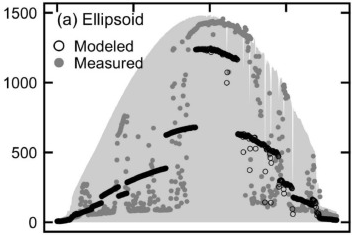Improving light modeling in agroforestry systems
By averaging in time and/or space, models predict less variable light patterns under tree canopies than in reality. We measured light every minute in 24 positions in a grid under different chestnut orchards, for several clear and overcast days. We also modelled this light with a purposely created 3D, spatially explicit, ray-tracing light interception model, where canopy porosity was calibrated to match measured daily light. Finally, we used both the measured and modeled light patterns transmitted under the tree canopies to estimate the daily net photosynthesis (An) and radiation use efficiency (RUE) of an understory wheat leaf. As expected, modeled light was more uniform than measured light, even at equal daily light. This resulted in large overestimation of daily An and RUE of the understory leaf. Averaging light in time increased the overestimations even further. A sensitivity analysis showed that this overestimation remained substantial over the range of realistic values for leaf photosynthetic parameters (i.e. Vc,max, Jmax, Rd) of the understory crop.
Rosati, A., Wolz K.J., Murphy L., Ponti L., Jose S., 2020. Modeling light below tree canopies overestimates net photosynthesis and radiation use efficiency in understory crops by averaging light in space and time. Agricultural and Forest Meteorology, https://doi.org/10.1016/j.agrformet.2019.107892
Rosati, A., Wolz K.J., Murphy L., Ponti L., Jose S., 2020. Modeling light below tree canopies overestimates net photosynthesis and radiation use efficiency in understory crops by averaging light in space and time. Agricultural and Forest Meteorology, https://doi.org/10.1016/j.agrformet.2019.107892
 |
| Averaging understory light patterns in time and space overestimates net photosynthesis and radiation use efficiency in agroforestry systems. |


Comments
Post a Comment